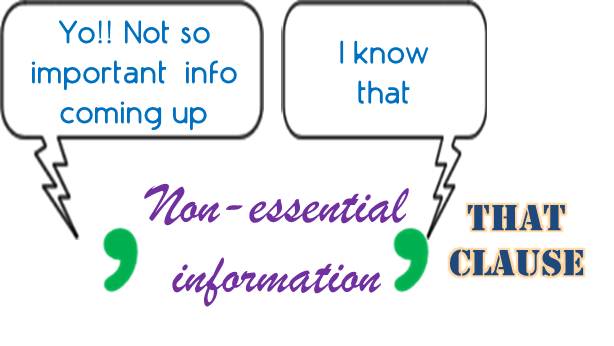A very common question that crops up time and again is whether to use COMMA before THAT or not. Today we will take a closer look at this and try to simplify the answer.
Grammatically COMMA + THAT is not correct usage. By definition ‘that clause’ presents required information or essential information and hence cannot be separated from the entity that it modifies by using a comma.
However this does not mean that you can never see a comma prior to that. When you do see comma before that, you will see a comma pair. In such cases non-essential information or additional information will be sandwiched between this comma pair. The sentence structure will look something like this:
Noun,noun-modifier,that clause
In the above structure, comma does not separate ‘that clause’ from its ‘noun’. The complete comma pair is used to separate out the ‘noun modifier’. Lets review this with some examples:
- Oprah Winfrey hosts a talk show that has won multiple awards. – Correct
- Oprah Winfrey hosts a talk show, that has won multiple awards. – Incorrect
- Oprah Winfrey hosts a talk show,considered the highest-rated program of its kind in history, that has won multiple awards. Correct
Note how in sentence 3, comma appears prior to ‘that’. But this comma does not separate the “that clause”. This comma separates the modifier phrase “considered …history”.
How does GMAT test this concept?
GMAT does not necessarily test this concept. But surely sentences in sentence correction questions incorporate the structure explained above. This implies that people who are not aware of this construction may unknowingly eliminate the answer choices that contain comma + that. For example, the two sentences below are excerpts from GMAT Prep questions.
Ozone, a special form of oxygen that screens out harmful ultraviolet rays, reaches high concentrations twelve miles above Earth, where it has long appeared that it was immune from human influence; we have now realized, though, that emissions of industrial chlorofluorocarbons deplete the ozone layer.
In this sentence, the non-underlined portion includes comma prior to that. But this comma does not separate the “that clause”. This comma separates the word ‘though’ from the rest of the sentence.
Galileo did not invent the telescope, but on hearing, in 1609, that such an optical instrument had been made, he quickly built his own device from an organ pipe and spectacle lenses.
In this sentence, the correct choice includes comma prior to that. But this comma does not separate “that clause”. This comma separates the phrase “in 1609” which modifies the action “hearing”.
What are the key take-away messages?
- Because ‘that clause’ provides essential information, it is not typically separated by a comma.
- When ‘that clause’ is preceded by a comma, the comma is part of comma pair that separates another “non-essential” information.
Where can you find more information?
Register at e-gmat to access Sentence Correction free trial.













